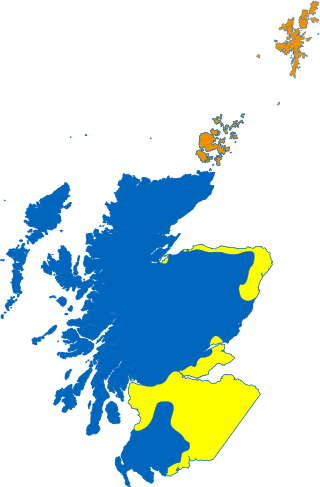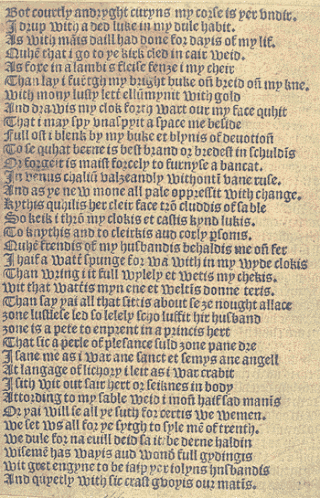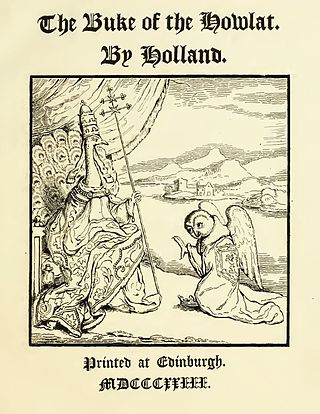
Robert I, popularly known as Robert the Bruce, was King of Scots from 1306 to his death in 1329. Robert led Scotland during the First War of Scottish Independence against England. He fought successfully during his reign to restore Scotland to an independent kingdom and is regarded in Scotland as a national hero.

John Barbour was a Scottish poet and the first major named literary figure to write in Scots. His principal surviving work is the historical verse romance, The Brus, and his reputation from this poem is such that other long works in Scots which survive from the period are sometimes thought to be by him. He is known to have written a number of other works, but other titles definitely ascribed to his authorship, such as The Stewartis Oryginalle and The Brut (Brutus), are now lost.

Sir James Douglas was a Scottish knight and feudal lord. He was one of the chief commanders during the Wars of Scottish Independence.

Thomas Randolph, Earl of Moray was a soldier and diplomat in the Wars of Scottish Independence, who later served as regent of Scotland. He was a nephew of Robert the Bruce, who created him as the first earl of Moray. He was known for successfully capturing Edinburgh Castle from the English, and he was one of the signatories of the Declaration of Arbroath.

"I that in Heill wes and Gladnes", also known as "The Lament for the Makaris", is a poem in the form of a danse macabre by the Scottish poet William Dunbar. Every fourth line repeats the Latin refrain timor mortis conturbat me, a litanic phrase from the Office of the Dead.

Early Scots was the emerging literary language of the Early Middle English-speaking parts of Scotland in the period before 1450. The northern forms of Middle English descended from Northumbrian Old English. During this period, speakers referred to the language as "English".
Middle Scots was the Anglic language of Lowland Scotland in the period from 1450 to 1700. By the end of the 15th century, its phonology, orthography, accidence, syntax and vocabulary had diverged markedly from Early Scots, which was virtually indistinguishable from early Northumbrian Middle English. Subsequently, the orthography of Middle Scots differed from that of the emerging Early Modern English standard that was being used in England. Middle Scots was fairly uniform throughout its many texts, albeit with some variation due to the use of Romance forms in translations from Latin or French, turns of phrases and grammar in recensions of southern texts influenced by southern forms, misunderstandings and mistakes made by foreign printers.

The Bruce campaign was a three-year military campaign in Ireland by Edward Bruce, brother of the Scottish king Robert the Bruce. It lasted from his landing at Larne in 1315 to his defeat and death in 1318 at the Battle of Faughart in County Louth. It was part of the First War of Scottish Independence against England, and the conflict between the Irish and Anglo-Normans.

Sir William Douglas of Nithsdale was a Scottish knight and Northern Crusader.

"The Taill of the Cok and the Jasp" is a Middle Scots version of Aesop's Fable The Cock and the Jewel by the 15th-century Scottish poet Robert Henryson. It is the first in Henryson's collection known as the Morall Fabillis of Esope the Phrygian. The Cok and the Jasp is framed by a prologue and a moralitas, and as the first poem in the collection it operates on a number of levels, and in all its parts, to introduce the larger cycle.
The Actes and Deidis of the Illustre and Vallyeant Campioun Schir William Wallace, also known as The Wallace, is a long "romantic biographical" poem by the fifteenth-century Scottish makar of the name Blind Harry, probably at some time in the decade before 1488. As the title suggests, it commemorates and eulogises the life and actions of the Scottish freedom fighter William Wallace who lived a century and a half earlier. The poem is historically inaccurate, and mentions several events that never happened. For several hundred years following its publication, The Wallace was the second most popular book in Scotland after the Bible.

The sleuth hound was a breed of dog. Broadly, it was a Scottish term for what in England was called the Bloodhound, although it seems that there were slight differences between them. It was also referred to as a 'slough dog',, and a 'slow hound', the first word likely representing a mispronunciation of 'slough' rather than a reference to the speed of the hound.
Adam Abell was a Scottish friar at Jedburgh Abbey. He wrote a chronicle in the 1530s that gives an insight into contemporary thought and contains anecdotes that appear in later writings. The manuscript of the Roit or Quheil of Tyme is kept at the National Library of Scotland, Ms. 1746. It was donated by Lt.-Colonel W. W. Cunninghame of Caprington.

The Tua Mariit Wemen and the Wedo or The Tretis Of The Twa Mariit Wemen and the Wedo is a narrative poem in Scots by the makar William Dunbar.

The Buke of the Howlat, often referred to simply as The Howlat, is a humorous 15th century Scots poem by Richard Holland.

Remonstrance to the King is a Scots poem of William Dunbar composed in the early sixteenth century. The Remonstrance is one of Dunbar's many appeals to his patron James IV of Scotland asking for personal advancement. In this particular case, the unseemly personal pleading is combined with more dignified subject matter; lavish praise and pointed criticism of the King's court is delivered in an open manner.

The Chepman and Myllar Press was the first printing press to be established in Scotland.
Sir Christopher Seton (1278–1306), also known as Christopher de Seton, was a 13th-century noble, who held lands in England and Scotland. He was a supporter of Robert the Bruce and obtained Robert's sister's hand in marriage. Present during the killing of John Comyn, Lord of Badenoch at Greyfriars Church, Dumfries, he also killed Sir Robert Comyn, who had rushed to Badenoch's aid. Seton was captured at Loch Doon Castle and executed at Dumfries in 1306.

The Thrissil and the Rois is a Scots poem composed by William Dunbar to mark the wedding, in August 1503, of King James IV of Scotland to Princess Margaret Tudor of England.

Friar Mark Hamilton was a Scottish Dominican and author of a History of the Hamiltons. His kinsman Regent Arran gave Friar Mark Hamilton £4 Scots for a friar's habit on 20 September 1553. Apart from his History and the record of the gift of a habit, few other details of Friar Mark's life are known.

















